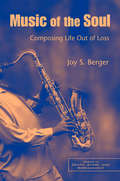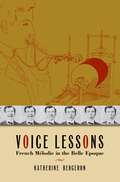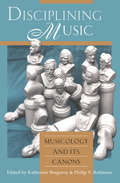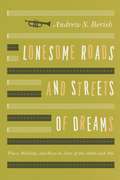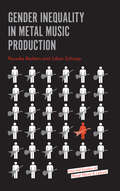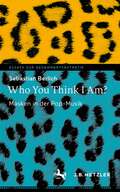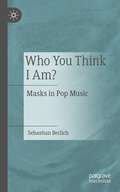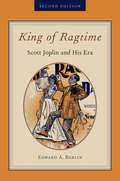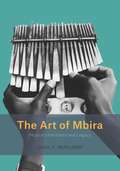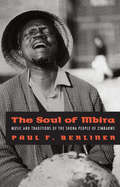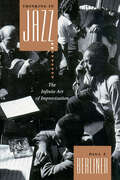- Table View
- List View
Music of the Soul: Composing Life Out of Loss (Series in Death, Dying, and Bereavement)
by Joy S. BergerMusic of the Soul guides the reader through principles, techniques, and exercises for incorporating music into grief counseling, with the end goal of further empowering the grieving person. Music has a unique ability to elicit a whole range of powerful emotional responses in people - even so far as altering or enhancing one's mood - as well as physical reactions. This interdisciplinary text draws in equal parts from contemporary grief/loss theory, music therapy research, historical examples of powerful music, case studies, and both self-reflecting and teaching exercises. Music is as much about beginnings as endings, and thus the book moves through life’s losses into its new beginnings, using musical expression to help the bereaved find meaning in loss and hurt, and move forward with their lives. With numerous exercises and examples for implementing the use of music in grief counseling, the book offers a practical and flexible approach to a broad spectrum of mental health practitioners, from thanatologists to hospice staff, at all levels of professional training and settings.
Music of the Soul: Composing Life Out of Loss (Series in Death, Dying, and Bereavement)
by Joy S. BergerMusic of the Soul guides the reader through principles, techniques, and exercises for incorporating music into grief counseling, with the end goal of further empowering the grieving person. Music has a unique ability to elicit a whole range of powerful emotional responses in people - even so far as altering or enhancing one's mood - as well as physical reactions. This interdisciplinary text draws in equal parts from contemporary grief/loss theory, music therapy research, historical examples of powerful music, case studies, and both self-reflecting and teaching exercises. Music is as much about beginnings as endings, and thus the book moves through life’s losses into its new beginnings, using musical expression to help the bereaved find meaning in loss and hurt, and move forward with their lives. With numerous exercises and examples for implementing the use of music in grief counseling, the book offers a practical and flexible approach to a broad spectrum of mental health practitioners, from thanatologists to hospice staff, at all levels of professional training and settings.
Jenseits der Vernunft: Form und Bedeutung in Wagners Musikdramen
by Karol BergerKarol Berger setzt Wagners Musikdramen in Beziehung zu den philosophischen und kulturellen Ideen seiner Zeit und konzentriert sich dabei in einer ausführlichen und gut verständlichen Analyse auf die vier Werke, die dieser in der zweiten Hälfte seiner Karriere schuf: „Der Ring des Nibelungen“, „Tristan und Isolde“, „Die Meistersinger von Nürnberg“ und „Parsifal“. Der Autor versucht, in das Geheimnis der Großform von Wagners Musikdramen einzudringen und erzielt überraschende Ergebnisse wie die Nähe Wagners zur italienischen Oper. Bei seiner Einordnung der Musikdramen auf der ideologischen Landkarte seiner Zeit relativieren sich, ganz gegen des Autors ursprüngliche Absicht, viele Einwände von Wagners Kritikern, allen voran Nietzsche.
A Theory of Art
by Karol BergerWhat, if anything, has art to do with the rest of our lives, and in particular with those ethical and political issues that matter to us most? Will art created today be likely to play a role in our lives as profound as that of the best art of the past? A Theory of Art shifts the focus of aesthetics from the traditional debate of "what is art?" to the engaging question of "what is art for?" Skillfully describing the social and historical situation of art today, author Karol Berger argues that music exemplifies the current condition of art in a radical, acute, and revealing fashion. He also uniquely combines aesthetics with poetics and hermeneutics. Offering a careful synthesis of a wide breadth of scholarship from art history, musicology, literary studies, political philosophy, ethics, and metaphysics, and written in a clear, accessible style, this book will appeal to anyone with a serious interest in the arts.
Voice Lessons: French Mélodie in the Belle Epoque (New Cultural History of Music)
by Katherine BergeronLanguage, education, politics, and music come together in Katherine Bergeron's Voice Lessons, a study of the French mélodie in the Belle Epoque. Close readings of songs by Fauré, Debussy, and Ravel, along with poems, sound recordings, and other historical documents, seek to uncovers the cultural meanings of this art: why it emerged, why it mattered, and why it eventually disappeared.
Disciplining Music: Musicology and Its Canons
by Katherine Bergeron Philip V. BohlmanProvocative and timely, Disciplining Music confronts a topic that has sparked considerable debate in recent years: how do musicians and music scholars "discipline" music in their efforts to confer order and meaning on it? This collection of essays addresses this issue by formulating questions about music's canons—rules that measure and order, negotiate cultural constraints, reconstruct the past, and shape the future. Written by scholars representing the fields of historical musicology, ethnomusicology, and music theory, many of the essays tug and push at the very boundaries of these traditional division within the study of music. "Fortunately, in a blaze of good-humored . . . scholarship, [this] book helps brains unaccustomed to thinking about the future without jeopardizing the past imagine the wonder classical-music life might become if it embraced all people and all musics."—Laurence Vittes, Los Angeles Reader "These essays will force us to rethink our position on many issues. . . [and] advance musicology into the twenty-first century."—Giulio Ongaro, American Music Teacher With essays by Katherine Bergeron, Philip V. Bohlman, Richard Cohn and Douglas Dempster, Philip Gossett, Robert P. Morgan, Bruno Nettl, Don Michael Randel, Ruth A. Solie, and Gary Tomlinson.
Lonesome Roads and Streets of Dreams: Place, Mobility, and Race in Jazz of the 1930s and '40s
by Andrew S. BerishAny listener knows the power of music to define a place, but few can describe the how or why of this phenomenon. In Lonesome Roads and Streets of Dreams: Place, Mobility, and Race in Jazz of the 1930s and ’40s, Andrew Berish attempts to right this wrong, showcasing how American jazz defined a culture particularly preoccupied with place. By analyzing both the performances and cultural context of leading jazz figures, including the many famous venues where they played, Berish bridges two dominant scholarly approaches to the genre, offering not only a new reading of swing era jazz but an entirely new framework for musical analysis in general, one that examines how the geographical realities of daily life can be transformed into musical sound. Focusing on white bandleader Jan Garber, black bandleader Duke Ellington, white saxophonist Charlie Barnet, and black guitarist Charlie Christian, as well as traveling from Catalina Island to Manhattan to Oklahoma City, Lonesome Roads and Streets of Dreams depicts not only a geography of race but how this geography was disrupted, how these musicians crossed physical and racial boundaries—from black to white, South to North, and rural to urban—and how they found expression for these movements in the insistent music they were creating.
Lonesome Roads and Streets of Dreams: Place, Mobility, and Race in Jazz of the 1930s and '40s
by Andrew S. BerishAny listener knows the power of music to define a place, but few can describe the how or why of this phenomenon. In Lonesome Roads and Streets of Dreams: Place, Mobility, and Race in Jazz of the 1930s and ’40s, Andrew Berish attempts to right this wrong, showcasing how American jazz defined a culture particularly preoccupied with place. By analyzing both the performances and cultural context of leading jazz figures, including the many famous venues where they played, Berish bridges two dominant scholarly approaches to the genre, offering not only a new reading of swing era jazz but an entirely new framework for musical analysis in general, one that examines how the geographical realities of daily life can be transformed into musical sound. Focusing on white bandleader Jan Garber, black bandleader Duke Ellington, white saxophonist Charlie Barnet, and black guitarist Charlie Christian, as well as traveling from Catalina Island to Manhattan to Oklahoma City, Lonesome Roads and Streets of Dreams depicts not only a geography of race but how this geography was disrupted, how these musicians crossed physical and racial boundaries—from black to white, South to North, and rural to urban—and how they found expression for these movements in the insistent music they were creating.
Lonesome Roads and Streets of Dreams: Place, Mobility, and Race in Jazz of the 1930s and '40s
by Andrew S. BerishAny listener knows the power of music to define a place, but few can describe the how or why of this phenomenon. In Lonesome Roads and Streets of Dreams: Place, Mobility, and Race in Jazz of the 1930s and ’40s, Andrew Berish attempts to right this wrong, showcasing how American jazz defined a culture particularly preoccupied with place. By analyzing both the performances and cultural context of leading jazz figures, including the many famous venues where they played, Berish bridges two dominant scholarly approaches to the genre, offering not only a new reading of swing era jazz but an entirely new framework for musical analysis in general, one that examines how the geographical realities of daily life can be transformed into musical sound. Focusing on white bandleader Jan Garber, black bandleader Duke Ellington, white saxophonist Charlie Barnet, and black guitarist Charlie Christian, as well as traveling from Catalina Island to Manhattan to Oklahoma City, Lonesome Roads and Streets of Dreams depicts not only a geography of race but how this geography was disrupted, how these musicians crossed physical and racial boundaries—from black to white, South to North, and rural to urban—and how they found expression for these movements in the insistent music they were creating.
Lonesome Roads and Streets of Dreams: Place, Mobility, and Race in Jazz of the 1930s and '40s
by Andrew S. BerishAny listener knows the power of music to define a place, but few can describe the how or why of this phenomenon. In Lonesome Roads and Streets of Dreams: Place, Mobility, and Race in Jazz of the 1930s and ’40s, Andrew Berish attempts to right this wrong, showcasing how American jazz defined a culture particularly preoccupied with place. By analyzing both the performances and cultural context of leading jazz figures, including the many famous venues where they played, Berish bridges two dominant scholarly approaches to the genre, offering not only a new reading of swing era jazz but an entirely new framework for musical analysis in general, one that examines how the geographical realities of daily life can be transformed into musical sound. Focusing on white bandleader Jan Garber, black bandleader Duke Ellington, white saxophonist Charlie Barnet, and black guitarist Charlie Christian, as well as traveling from Catalina Island to Manhattan to Oklahoma City, Lonesome Roads and Streets of Dreams depicts not only a geography of race but how this geography was disrupted, how these musicians crossed physical and racial boundaries—from black to white, South to North, and rural to urban—and how they found expression for these movements in the insistent music they were creating.
Lonesome Roads and Streets of Dreams: Place, Mobility, and Race in Jazz of the 1930s and '40s
by Andrew S. BerishAny listener knows the power of music to define a place, but few can describe the how or why of this phenomenon. In Lonesome Roads and Streets of Dreams: Place, Mobility, and Race in Jazz of the 1930s and ’40s, Andrew Berish attempts to right this wrong, showcasing how American jazz defined a culture particularly preoccupied with place. By analyzing both the performances and cultural context of leading jazz figures, including the many famous venues where they played, Berish bridges two dominant scholarly approaches to the genre, offering not only a new reading of swing era jazz but an entirely new framework for musical analysis in general, one that examines how the geographical realities of daily life can be transformed into musical sound. Focusing on white bandleader Jan Garber, black bandleader Duke Ellington, white saxophonist Charlie Barnet, and black guitarist Charlie Christian, as well as traveling from Catalina Island to Manhattan to Oklahoma City, Lonesome Roads and Streets of Dreams depicts not only a geography of race but how this geography was disrupted, how these musicians crossed physical and racial boundaries—from black to white, South to North, and rural to urban—and how they found expression for these movements in the insistent music they were creating.
Lonesome Roads and Streets of Dreams: Place, Mobility, and Race in Jazz of the 1930s and '40s
by Andrew S. BerishAny listener knows the power of music to define a place, but few can describe the how or why of this phenomenon. In Lonesome Roads and Streets of Dreams: Place, Mobility, and Race in Jazz of the 1930s and ’40s, Andrew Berish attempts to right this wrong, showcasing how American jazz defined a culture particularly preoccupied with place. By analyzing both the performances and cultural context of leading jazz figures, including the many famous venues where they played, Berish bridges two dominant scholarly approaches to the genre, offering not only a new reading of swing era jazz but an entirely new framework for musical analysis in general, one that examines how the geographical realities of daily life can be transformed into musical sound. Focusing on white bandleader Jan Garber, black bandleader Duke Ellington, white saxophonist Charlie Barnet, and black guitarist Charlie Christian, as well as traveling from Catalina Island to Manhattan to Oklahoma City, Lonesome Roads and Streets of Dreams depicts not only a geography of race but how this geography was disrupted, how these musicians crossed physical and racial boundaries—from black to white, South to North, and rural to urban—and how they found expression for these movements in the insistent music they were creating.
Gender Inequality in Metal Music Production (Emerald Studies in Metal Music and Culture)
by Pauwke Berkers Julian SchaapFor over four decades, scholars have been investigating male dominance - both symbolically and numerically -within popular music. The heavier genres of popular music, metal music in particular, have been male dominated spaces, which are difficult to navigate for women participating as fans, musicians, or both. Studies on gender inequality in metal music have convincingly demonstrated how gender dynamics shape the reception of metal music and metal scenes all over the globe. Yet, they shed relatively little light on the extent of and reasons for metal music's male domination from a production perspective. This book fills this gap, offering is a systematic and large-scale overview of gender inequality in metal music production. In other words: how many women - compared to men - are participating in metal bands and what are the causes for the differences in participation?
Gender Inequality in Metal Music Production (Emerald Studies in Metal Music and Culture)
by Pauwke Berkers Julian SchaapFor over four decades, scholars have been investigating male dominance - both symbolically and numerically -within popular music. The heavier genres of popular music, metal music in particular, have been male dominated spaces, which are difficult to navigate for women participating as fans, musicians, or both. Studies on gender inequality in metal music have convincingly demonstrated how gender dynamics shape the reception of metal music and metal scenes all over the globe. Yet, they shed relatively little light on the extent of and reasons for metal music's male domination from a production perspective. This book fills this gap, offering is a systematic and large-scale overview of gender inequality in metal music production. In other words: how many women - compared to men - are participating in metal bands and what are the causes for the differences in participation?
Berkmann's Pop Miscellany: Sex, Drugs and Cars in Swimming Pools
by Marcus BerkmannMarcus Berkmann was for many years the pop critic of the Spectator, waiting like most freelances to get fired. He's also the author of the bestselling Berkmann's Cricket Miscellany, concentrating on the ridiculous true stories and the weird characters of that most eccentric of sports. Here he combines the two, in a wildly entertaining ride through the galloping absurdities of pop, from Elvis Presley's real hair colour, through Janet Jackson's more intimate piercings, to Courtney Love's hatred of cheese. Why does Bono always wear sunglasses? Did Ozzy Osbourne really urinate on the Alamo? What actually happened at Keith Moon's 21st birthday party at the Holiday Inn in Flint, Michigan? There's sex, there's drugs, there's violence, there's even a little rock 'n' roll from time to time. But mainly there are vital questions, now finally answered. Which notable guitarist has unfeasibly tiny hands? Which Britpop star was forced to wear lederhosen as a child? Who said, 'The majority of pop stars are compete idiots in every respect'? And was she wrong?
Who You Think I Am?: Masken in der Pop-Musik (Essays zur Gegenwartsästhetik)
by Sebastian BerlichPop-Stars sind uns nahe. In ihren Songs, ihren Bildern, ihren Stories auf Instagram. Gesucht ist ein authentischer Eindruck. Echte Gefühle auf echten Gesichtern. Aber was passiert, wenn sie ihr Gesicht mit einer Maske verdecken? Und zwar dauerhaft, als zweites Gesicht. Das Phänomen findet sich im Mainstream wie im Underground. Die Maske bricht dabei nicht mit dem Ideal von Authentizität. Vielmehr verweist sie je nach Inszenierung auf verschiedenste Diskurse, kann cool oder grotesk wirken, zum Logo werden oder Anonymität herstellen. Der Essay zeigt an zwei Beispielfällen (Sido, Slipknot), wie die Maske die Persona von Pop-Stars konstruiert – und enthüllt damit Strukturen der Pop-Musik.
Who You Think I Am?: Masks in Pop Music
by Sebastian BerlichPop stars are close to us. In their songs, their pictures, their stories on Instagram. What we are looking for is an authentic impression. Real feelings on real faces. But what happens when they cover their face with a mask? Permanently, as a second face. The phenomenon can be found in the mainstream as well as in the underground. The mask does not break with the ideal of authenticity. Rather, depending on how it is staged, it refers to the most diverse discourses, can appear cool or grotesque, become a logo or create anonymity. The essay uses mainly two examples (Sido, Slipknot) to show how the mask constructs the persona of pop stars - and thus reveals structures of pop music.
King of Ragtime: Scott Joplin and His Era
by Edward A. BerlinWhen it was first published in 1994, King of Ragtime: Scott Joplin and his Era was widely heralded not only as the most thorough investigation of Scott Joplin's life and music, but also as a gripping read, almost a detective story. This new and expanded edition-more than a third larger than the first-goes far beyond the original publication in uncovering new details of the composer's life and insights into his music. It explores Joplin's early, pre-ragtime career as a quartet singer, a period of his life that was previously unknown. The book also surveys the nature of ragtime before Joplin entered the ragtime scene and how he changed the style. Author Edward A. Berlin offers insightful commentary on each of all of Joplin's works, showing his influence on other ragtime and non-ragtime composers. He traces too Joplin's continued music studies late in life, and how these reflect his dedication to education and probably account for the radical changes that occur in his last few rags. And he puts new emphasis on Joplin's efforts in musical theater, bringing in early versions of his Ragtime Dance and its precedents. Joplin's wife Freddie is shown to be a major inspiration to his opera Treemonisha, with her family background and values being reflected in that work. Joplin's reputation faded in the 1920s-30s, but interest in his music slowly re-emerged in the 1940s and gradually built toward a spectacular revival in the 1970s, when major battles ensued for possession of rights.
King of Ragtime: Scott Joplin and His Era
by Edward A. BerlinWhen it was first published in 1994, King of Ragtime: Scott Joplin and his Era was widely heralded not only as the most thorough investigation of Scott Joplin's life and music, but also as a gripping read, almost a detective story. This new and expanded edition-more than a third larger than the first-goes far beyond the original publication in uncovering new details of the composer's life and insights into his music. It explores Joplin's early, pre-ragtime career as a quartet singer, a period of his life that was previously unknown. The book also surveys the nature of ragtime before Joplin entered the ragtime scene and how he changed the style. Author Edward A. Berlin offers insightful commentary on each of all of Joplin's works, showing his influence on other ragtime and non-ragtime composers. He traces too Joplin's continued music studies late in life, and how these reflect his dedication to education and probably account for the radical changes that occur in his last few rags. And he puts new emphasis on Joplin's efforts in musical theater, bringing in early versions of his Ragtime Dance and its precedents. Joplin's wife Freddie is shown to be a major inspiration to his opera Treemonisha, with her family background and values being reflected in that work. Joplin's reputation faded in the 1920s-30s, but interest in his music slowly re-emerged in the 1940s and gradually built toward a spectacular revival in the 1970s, when major battles ensued for possession of rights.
The Art of Mbira: Musical Inheritance and Legacy (Chicago Studies in Ethnomusicology)
by Paul F. BerlinerGrowing out of the collaborative research of an American ethnomusicologist and Zimbabwean musician, Paul F. Berliner’s The Art of Mbira documents the repertory for a keyboard instrument known generally as mbira. At the heart of this work lies the analysis of the improvisatory processes that propel mbira music’s magnificent creativity. In this book, Berliner provides insight into the communities of study, performance, and worship that surround mbira. He chronicles how master player Cosmas Magaya and his associates have developed their repertory and practices over more than four decades, shaped by musical interaction, social and political dynamics in Zimbabwe, and the global economy of the music industry. At once a detailed exposition of the music’s forms and practices, it is also an indispensable historical and cultural guide to mbira in a changing world. Together with Berliner and Magaya's compendium of mbira compositions, Mbira’s Restless Dance, The Art of Mbira breaks new ground in the depth and specificity of its exploration of an African musical tradition, and in the entwining of the authors’ collaborative voices. It is a testament to the powerful relationship between music and social life—and the rewards of lifelong musical study, performance, and friendship.
The Art of Mbira: Musical Inheritance and Legacy (Chicago Studies in Ethnomusicology)
by Paul F. BerlinerGrowing out of the collaborative research of an American ethnomusicologist and Zimbabwean musician, Paul F. Berliner’s The Art of Mbira documents the repertory for a keyboard instrument known generally as mbira. At the heart of this work lies the analysis of the improvisatory processes that propel mbira music’s magnificent creativity. In this book, Berliner provides insight into the communities of study, performance, and worship that surround mbira. He chronicles how master player Cosmas Magaya and his associates have developed their repertory and practices over more than four decades, shaped by musical interaction, social and political dynamics in Zimbabwe, and the global economy of the music industry. At once a detailed exposition of the music’s forms and practices, it is also an indispensable historical and cultural guide to mbira in a changing world. Together with Berliner and Magaya's compendium of mbira compositions, Mbira’s Restless Dance, The Art of Mbira breaks new ground in the depth and specificity of its exploration of an African musical tradition, and in the entwining of the authors’ collaborative voices. It is a testament to the powerful relationship between music and social life—and the rewards of lifelong musical study, performance, and friendship.
The Art of Mbira: Musical Inheritance and Legacy (Chicago Studies in Ethnomusicology)
by Paul F. BerlinerGrowing out of the collaborative research of an American ethnomusicologist and Zimbabwean musician, Paul F. Berliner’s The Art of Mbira documents the repertory for a keyboard instrument known generally as mbira. At the heart of this work lies the analysis of the improvisatory processes that propel mbira music’s magnificent creativity. In this book, Berliner provides insight into the communities of study, performance, and worship that surround mbira. He chronicles how master player Cosmas Magaya and his associates have developed their repertory and practices over more than four decades, shaped by musical interaction, social and political dynamics in Zimbabwe, and the global economy of the music industry. At once a detailed exposition of the music’s forms and practices, it is also an indispensable historical and cultural guide to mbira in a changing world. Together with Berliner and Magaya's compendium of mbira compositions, Mbira’s Restless Dance, The Art of Mbira breaks new ground in the depth and specificity of its exploration of an African musical tradition, and in the entwining of the authors’ collaborative voices. It is a testament to the powerful relationship between music and social life—and the rewards of lifelong musical study, performance, and friendship.
The Soul of Mbira: Music and Traditions of the Shona People of Zimbabwe
by Paul F. BerlinerThis sensitive, scholarly portrayal of Shona musicians and the African Musical tradition is highly engaging and comprehensive in its range of data. Paul Berliner provides the complete cultural context for the music and an intimate, precise account of the meaning of the instrument and its music. "Paul Berliner's The Soul of Mbira is probably the best ethnography ever written about an African musical tradition. It is a complete classic . . . . I know of no other instrument with the range of the mbira, and the book is equal to the instrument."—John Chernoff "[The Soul of Mbira] illustrates the fact that Shona mbira music in its beauty, subtlety, and virtuosity demands the same kind of respect that we might hold for any other classical music."—David Reck, Parabola "The book is a model of ethnomusicological thinking and investigation and it suggests a specific way of approaching a complex socio-musical system."—John Baily, Popular Music "When next someone asks 'What is ethnomusicology?' or 'What do ethnomusicologists do?' I shall suggest this book. . . . This is a landmark in ethnomusicological literature. Berliner succeeds in conveying both the joy that goes with mbira playing and the mystic relationship between the player and his instrument. In short, this is humanized ethnomusicology."—K.A. Gourlay, Ethnomusicology
Thinking in Jazz: The Infinite Art of Improvisation (Chicago Studies in Ethnomusicology)
by Paul F. BerlinerA landmark in jazz studies, Thinking in Jazz reveals as never before how musicians, both individually and collectively, learn to improvise. Chronicling leading musicians from their first encounters with jazz to the development of a unique improvisatory voice, Paul Berliner documents the lifetime of preparation that lies behind the skilled improviser's every idea. The product of more than fifteen years of immersion in the jazz world, Thinking in Jazz combines participant observation with detailed musicological analysis, the author's experience as a jazz trumpeter, interpretations of published material by scholars and performers, and, above all, original data from interviews with more than fifty professional musicians: bassists George Duvivier and Rufus Reid; drummers Max Roach, Ronald Shannon Jackson, and Akira Tana; guitarist Emily Remler; pianists Tommy Flanagan and Barry Harris; saxophonists Lou Donaldson, Lee Konitz, and James Moody; trombonist Curtis Fuller; trumpeters Doc Cheatham, Art Farmer, Wynton Marsalis, and Red Rodney; vocalists Carmen Lundy and Vea Williams; and others. Together, the interviews provide insight into the production of jazz by great artists like Betty Carter, Miles Davis, Dizzy Gillespie, Coleman Hawkins, and Charlie Parker. Thinking in Jazz overflows with musical examples from the 1920s to the present, including original transcriptions (keyed to commercial recordings) of collective improvisations by Miles Davis's and John Coltrane's groups. These transcriptions provide additional insight into the structure and creativity of jazz improvisation and represent a remarkable resource for jazz musicians as well as students and educators. Berliner explores the alternative ways—aural, visual, kinetic, verbal, emotional, theoretical, associative—in which these performers conceptualize their music and describes the delicate interplay of soloist and ensemble in collective improvisation. Berliner's skillful integration of data concerning musical development, the rigorous practice and thought artists devote to jazz outside of performance, and the complexities of composing in the moment leads to a new understanding of jazz improvisation as a language, an aesthetic, and a tradition. This unprecedented journey to the heart of the jazz tradition will fascinate and enlighten musicians, musicologists, and jazz fans alike.
Thinking in Jazz: The Infinite Art of Improvisation (Chicago Studies in Ethnomusicology)
by Paul F. BerlinerA landmark in jazz studies, Thinking in Jazz reveals as never before how musicians, both individually and collectively, learn to improvise. Chronicling leading musicians from their first encounters with jazz to the development of a unique improvisatory voice, Paul Berliner documents the lifetime of preparation that lies behind the skilled improviser's every idea. The product of more than fifteen years of immersion in the jazz world, Thinking in Jazz combines participant observation with detailed musicological analysis, the author's experience as a jazz trumpeter, interpretations of published material by scholars and performers, and, above all, original data from interviews with more than fifty professional musicians: bassists George Duvivier and Rufus Reid; drummers Max Roach, Ronald Shannon Jackson, and Akira Tana; guitarist Emily Remler; pianists Tommy Flanagan and Barry Harris; saxophonists Lou Donaldson, Lee Konitz, and James Moody; trombonist Curtis Fuller; trumpeters Doc Cheatham, Art Farmer, Wynton Marsalis, and Red Rodney; vocalists Carmen Lundy and Vea Williams; and others. Together, the interviews provide insight into the production of jazz by great artists like Betty Carter, Miles Davis, Dizzy Gillespie, Coleman Hawkins, and Charlie Parker. Thinking in Jazz overflows with musical examples from the 1920s to the present, including original transcriptions (keyed to commercial recordings) of collective improvisations by Miles Davis's and John Coltrane's groups. These transcriptions provide additional insight into the structure and creativity of jazz improvisation and represent a remarkable resource for jazz musicians as well as students and educators. Berliner explores the alternative ways—aural, visual, kinetic, verbal, emotional, theoretical, associative—in which these performers conceptualize their music and describes the delicate interplay of soloist and ensemble in collective improvisation. Berliner's skillful integration of data concerning musical development, the rigorous practice and thought artists devote to jazz outside of performance, and the complexities of composing in the moment leads to a new understanding of jazz improvisation as a language, an aesthetic, and a tradition. This unprecedented journey to the heart of the jazz tradition will fascinate and enlighten musicians, musicologists, and jazz fans alike.
